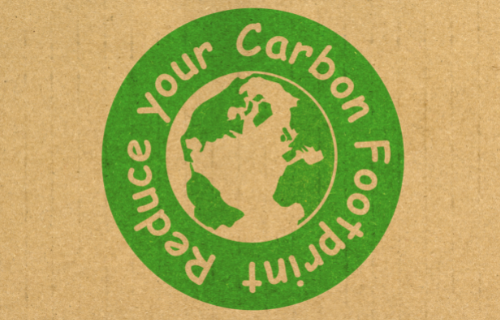Difference Between Carbon Reduction and Carbon Offset

Carbon Reduction
Carbon reduction refers to the process of drawing down carbon dioxide emissions and other carbon-based greenhouse gas emissions produced by civilization or a particular industry. Carbon dioxide in the atmosphere is mostly a byproduct of geologic processes, such as volcanism, and biologic processes, such as exhalation of animals that breath oxygen and exhale carbon dioxide as a waste product. Another way that carbon dioxide is introduced into the atmosphere is through the burning of fossil fuels, such as coal, oil, and natural gas. The burning of fossil fuels has been responsible for most of the new carbon dioxide in the atmosphere since the Industrial Revolution, beginning in the late 18th century.
Background
Carbon dioxide is important because it is a greenhouse gas, meaning that it traps heat from the sun, warming up the atmosphere. Energy from sunlight will be absorbed by Earth’s surface and then re-emitted as infrared radiation, heat. Carbon dioxide in the atmosphere will absorb the infrared energy coming from Earth’s surface and re-emit about half of it towards Earth. As a result, heat that would have escaped into space remains in the atmosphere and the atmosphere warms. Another important carbon-based compound known to be a greenhouse gas is methane.
Fossil fuels, such as coal oil, and natural gas, represent the remains of organisms which existed millions of years ago. The carbon from these organisms is encased in ancient sedimentary rock and has thus been removed from the atmosphere. When fossil fuels are burned, the carbon from this ancient reservoir is re-introduced into the atmosphere as carbon dioxide. This can increase the greenhouse effect if enough carbon dioxide is added to the atmosphere, causing a rise in the global average temperature.
The burning of fossil fuels since the Industrial Revolution has increased the concentration of carbon dioxide enough that it is causing a change to the global climate regime in which human civilization developed. The future global climate is one to which human civilization is not adapted and presents a challenge to future human welfare and the welfare of Earth’s biosphere. This has motivated governments and non-governmental organizations to work to reduce carbon dioxide and other greenhouse gas emissions in order to slow the change in climate so that it does not disrupt civilization or natural ecosystems.
Approaches to carbon reduction
Much of the current global energy and industrial infrastructure is still based on carbon-intensive processes, such as the burning of coal and oil. As a result, the transition to low carbon or carbon neutral forms of energy production, such as wind and solar power, can be expensive and require incentive. The two main approaches that governments have taken to incentivizing carbon reduction are a carbon tax and a carbon cap and trade system.
Carbon tax
Since carbon emissions will have an impact on the future economy because of climate change, carbon emissions have an associated cost. For example, one ton of carbon emitted has an associated cost of about $40. This cost, however, is not directly paid by the individual. It will however be paid for in the future in the form of infrastructure investment needed to deal with climate change adaptation if carbon emissions are not sufficiently reduced. One way to make this tangible is to have companies or individuals pay for it in the form of a tax. A desirable consequence of the carbon tax is that individuals and companies will be motivated to turn to less carbon-intensive activities, or at least engage less in carbon-intensive activities, so that they do not have to pay as much in taxes.
Cap and trade
The cap-and-trade system works by placing a cap on the maximum allowed carbon emissions per year and allowing companies to receive or purchase carbon “shares” which act as permits to emit a certain amount of carbon in a carbon market. The advantage of this system is that there is a fixed, controllable limit on carbon emissions. This approach is currently being employed in the European Union as a way of following the Kyoto Protocol that went into effect in 2005.

Carbon Offset
Carbon offset is a financial way to fund programs that reduce carbon emissions. A company or individual can purchase a carbon offset for a carbon-intensive activity to fund projects that reduce carbon emissions. For example, a rental car company may offer a potential renter a carbon offset intended to fund planting trees to sequester carbon.
Is carbon offsetting the same as carbon removal?
Although carbon offsetting helps to fund activities that lead to carbon removal, it does not necessarily result in carbon removal. Carbon offsetting will result in carbon removal if the carbon offset is funding a program that removes carbon, but if it is funding a program that merely reduces the emission of new carbon into the atmosphere, such as a wind or solar farm, it will not result in carbon removal. As a result, carbon offsetting and carbon removal are related but not the same thing since carbon offsetting does not necessarily mean carbon removal.
What is the difference between carbon offsetting and carbon sequestration?
Carbon sequestration refers to the removal of carbon dioxide and other carbon-based greenhouse gases from the atmosphere through capture and storage. This can be done in two ways, biologic sequestration or geologic sequestration.
In biologic sequestration, carbon is stored in the form of plants, soil, and in aquatic environments. Plants absorb carbon dioxide and, if the soil is healthy, a significant percentage of the carbon from the carbon dioxide absorbed by plants will end up in the soil. This creates a carbon sink. This is one reason why planting trees and encouraging the growth of natural forests is being encouraged to combat climate change since it results in a carbon sink. Geological approaches to carbon sequestration involve storing carbon dioxide in underground rock formations. In the case of carbon dioxide, the gas will be liquidized, through subjection to high pressure, and injected into porous rock.
Although carbon offsets can result in carbon sequestration, carbon offsets differ in important ways from carbon sequestration. Carbon sequestration is a type of carbon removal in which carbon is directly removed from the atmosphere and stored either in geological formations or in living systems. Carbon offsets are a financial way to counteract the emissions from a carbon-intensive activity by funding an activity which cancels out the offending carbon emission through carbon removal or emissions reduction.
What does carbon offset mean?
The term carbon offset is used because a carbon intensive activity is being made up for by funding a corresponding activity that reduces or removes carbon from the atmosphere. In other words, a carbon emission in one part of the system is being offset by a drawdown in carbon, usually carbon dioxide, in another part of the system. The idea is that if atmospheric carbon dioxide is being increased in one way, it must be reduced in another way to keep carbon emissions down so that the atmospheric concentration of carbon dioxide does not increase.
What is an example of a carbon offset?
A common example of a carbon offset is an airline giving passengers the option of purchasing an offset for their contribution to the carbon emissions from their flight. This offset might be used to fund carbon sequestration in another part of the world. Any company can do this since the production of most commodities involves carbon emissions at some point, whether food, clothing, or transportation. A market is being created around carbon offsets where third party vendors will sell offsets to companies which the companies can sell to their customers, allowing them to offset their personal contribution to the carbon footprint of the company’s activities. In theory, this means that for every ton of carbon dioxide that is introduced into the atmosphere, a ton will be removed, resulting in a net zero emission of carbon dioxide. How it works in practice is another matter.
Similarities between carbon reduction and carbon offset
Carbon reduction and carbon offsetting both aim to limit the amount of carbon dioxide and other carbon-based greenhouses gases being released into the atmosphere. Both also intend to make more tangible the future economic cost of climate change.
Differences between carbon reduction and carbon offset
Although there are similarities between carbon reduction and carbon offsetting, there are also important differences. These include the following.
- Carbon reduction involves directly reducing carbon emissions, while carbon offsetting allows carbon emissions by promising to cancel out the emissions through funding carbon reduction or removal.
- Carbon reduction involves implementing taxes or regulations to limit emissions, whereas carbon offsetting provides funding for programs that reduce or remove carbon in the atmosphere.
- Carbon reduction intends to reduce carbon emissions over time, whereas carbon offsetting simply seeks to keep emissions from increasing by cancelling out new carbon emissions with carbon removal or emissions reduction.
- Carbon reduction encourages individuals and companies to stop emitting as much carbon, whereas carbon offsetting encourages individuals to pay extra for carbon emissions.
Carbon Reduction vs. Carbon Offset

Summary
Carbon reduction refers to directly reducing carbon emissions in the atmosphere through incentivizing companies and individuals to reduce their carbon emissions through a carbon tax or regulations that limit the total carbon emissions permitted. The two main approaches are a carbon tax on companies and individuals for their emissions and a cap-and-trade system. In the cap-and-trade regime, a cap is placed on allowed carbon emissions and companies can buy “carbon shares,” allowing them to emit certain amounts of carbon dioxide into the atmosphere per year. Carbon offsetting involves financially offsetting carbon emissions through funding activities that lead to carbon removal or carbon emissions reduction. The goal of carbon offsets is that carbon emissions are balanced out by an equal amount of carbon being removed from the atmosphere through activities funded through the offset. An example of this is when companies give customers the option of purchasing an offset which will then be used to fund reforestation efforts in another part of the world. Carbon reduction and carbon offsetting are similar in that they both aim to limit new carbon entering the atmosphere and make the economic cost of future climate change more tangible. They also have important differences. Carbon offsets indirectly reduce carbon through funding carbon removal or carbon emissions reduction, focus on preventing new emissions, and encourage companies and individuals to financially support carbon emissions reduction and carbon removal efforts in the process. Carbon reduction tries to directly limit carbon emissions and to progressively reduce carbon emissions over time. It also directly discourages carbon intensive activities by making them more expensive through a carbon tax or regulations.
- Difference Between Environmental Performance Index and Development - November 24, 2023
- Difference Between Environmental Intervention and Development - November 8, 2023
- Difference Between Eco Efficiency and Eco Effectiveness - September 18, 2023
Search DifferenceBetween.net :
Leave a Response
References :
[0]Betts, Richard. “Met Office: Atmospheric CO2 now hitting 50% higher than pre-industrial levels.” Carbon Brief, 16 Mar. 2021, https://www.carbonbrief.org/met-office-atmospheric-co2-now-hitting-50-higher-than-pre-industrial-levels. Accessed 25 Mar. 2022.
[1]Bralower, Timothy, and David Bice. “Strategies for Reducing Carbon Emissions.” Earth 103: Earth in the Future, https://www.e-education.psu.edu/earth103/node/744. Accessed 25 Mar. 2022.
[2]Lindsey, Rebecca. “How do we know the build-up of carbon dioxide in the atmosphere is caused by humans?” Climate.gov, https://www.climate.gov/news-features/climate-qa/how-do-we-know-build-carbon-dioxide-atmosphere-caused-humans.
[3]Magdoff, Fred. “Repairing the Soil Carbon Rift.” Monthly Review, 1 Apr. 2021,https://monthlyreview.org/2021/04/01/repairing-the-soil-carbon-rift/. Accessed 9 Apr. 2022.
[4]Rodia, Tina. “Offsetting carbon emissions, one ton at a time.” Penn Today, 20 July 2020, https://penntoday.upenn.edu/news/offsetting-carbon-emissions-one-ton-time. Accessed 25 Mar. 2022.
[5]White, Matthew. “The Industrial Revolution.” British Library, https://www.bl.uk/georgian-britain/articles/the-industrial-revolution. Accessed 1 Apr. 2022.
